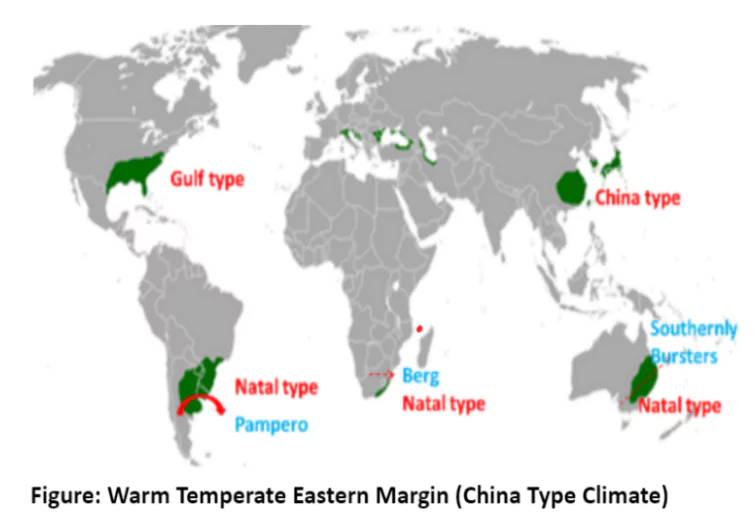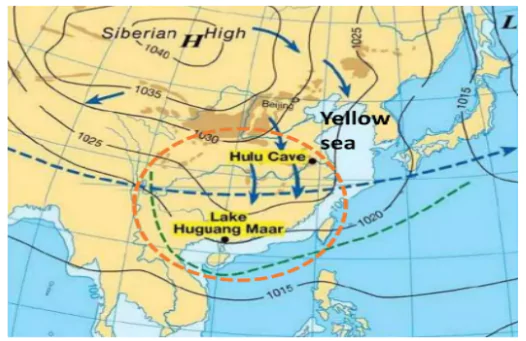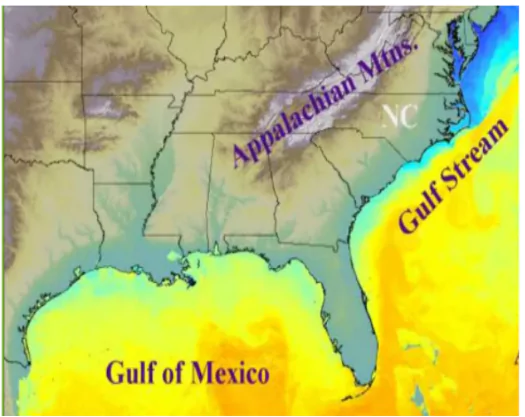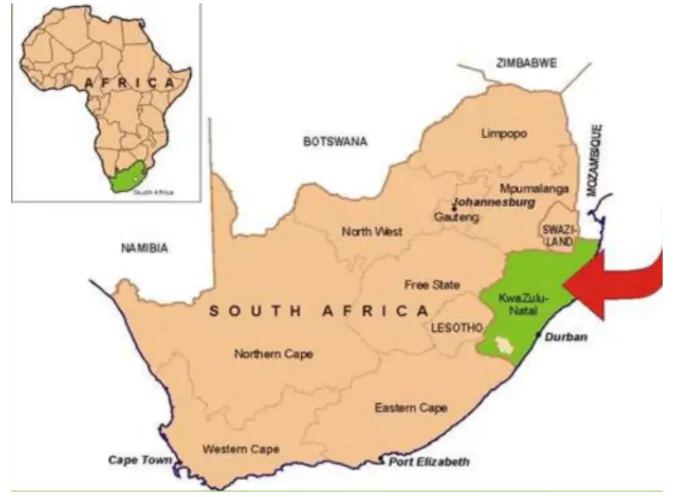Introduction
The Warm Temperate Eastern Margin, also known as the China Type climate, is found on the eastern edges of continents in warm temperate latitudes. It is characterized by warm, moist summers and cool, dry winters; these regions experience significant rainfall throughout the year supporting diverse economic activities such as rice cultivation, sugarcane farming, and lush vegetation.
Overview of Warm Temperate Eastern Margin Climates, Vegetation and Economic Activities
Distribution
- It is a modified form of monsoonal climate, found on the eastern margins of continents in warm temperate latitudes, just outside the tropics.
- In summer, the regions are under the influence of moist, maritime airflow from the subtropical anti-cyclonic cells.
- More rainfall compared to the Mediterranean climate at similar latitudes occurs mostly during the summer months.
 Northern Hemisphere:
Northern Hemisphere:
- China Type: It’s commonly seen in China and southern Japan, resembling a modified monsoonal climate hence known as Temprate Monsson or China Type and.
- Gulf Type: Southeastern USA (near the Gulf of Mexico); the influence of continental heating in summer brings in cooler air from the Atlantic Ocean, resembling the China type.
- Southern Hemisphere: similar climates are found along the warm temperate eastern coastlands of continents like Australia, Africa, and South America.
- Natal type: Influenced by onshore trade winds year-round rather than distinct monsoon patterns.
Enroll now for UPSC Online Course
Climate
- Warm moist summer and cool, dry winter; strong maritime influence; small annual temperature range.
- In summer, the regions are under the influence of moist, maritime airflow from the subtropical anti-cyclonic cells
- Rainfall throughout the year (60 to 150 cm); Rainfall from Conventional sources or as orographic rain in summer, or from depressions in winter.
- Local storms: Typhoons tropical cyclones), and Hurricanes, also occur
Subdivided Into Three Main Types

- China Type (Central and North China, South Japan): temperate monsoonal; great annual temperature range; rain in summer and winter; occurrence of typhoons in late summer;
- South-East Monsoon: During summer, low pressure over Asia draws in the rain-bearing Southeast monsoon, causing heavy precipitation across China, especially along the coast.
- North-West Monsoon: Winter sees a steep pressure gradient between Mongolia/Siberia and the Pacific coast, resulting in the dry North-West Monsoon with little rain but considerable snow in some areas.
- Annual Temperature Range: is significant, with a difference of up to 45°F in places like Nanking.
- Typhoons: intense tropical cyclones originating in the Pacific Ocean, affect southern China from July to September, causing strong winds, heavy rainfall, and flooding.
 Gulf Type (South Eastern USA): slight monsoonal; no distinct dry period; occurrence of hurricanes and tornadoes.
Gulf Type (South Eastern USA): slight monsoonal; no distinct dry period; occurrence of hurricanes and tornadoes.
- Experienced in the Gulf-Atlantic regions of the United States, shares similarities with central China’s climate but lacks well-defined monsoonal characteristics.
- Temperature Difference: This is relatively small due to the influence of the warm Gulf Stream and onshore trade winds.
- Summers: are warm and pleasant, while winters rarely see snowfall.
- Annual Rainfall: is heavy, with no distinct dry period, fostering extensive cultivation of cotton and maize in the Cotton and Corn Belts.
- Rainfall peaks in summer, augmented by thunderstorms and hurricanes in September and October.
 Tornadoes: resulting from intense local heating, can cause significant damage, especiall in the central plain.
Tornadoes: resulting from intense local heating, can cause significant damage, especiall in the central plain.
- Natal type: Natal, Eastern Australia, Southern Brazil, Paraguay, Uruguay and Northern Argentina and all warm eastern temperate margins of southern hemisphere; Dominance of maritime influence.
- It lacks the monsoonal elements seen in the corresponding climates of the northern hemisphere due to narrow continents and maritime influence.
- Rainfall: is evenly distributed throughout the year, supporting agricultural activities.
- The passage of depressions results in a slight autumn or winter rainfall peak.
- Temperature Range: exhibits a small annual range, with no really cold months.
- Local Winds: Southerly Buster (Cold Wind in Australia) impacts New South Wales and Victoria ; Pampero (Cold Dry Wind in Argentina & Uruguay; Berg (Hot & Dry Wind in South Africa) brings heavy precipitation to Natal, benefiting agriculture.
- Not as severe as typhoons or tornadoes, can still have significant impacts.
Vegetation
- Lush vegetation with evergreen broad-leaved forests and deciduous hardwood trees in lowlands due to well-distributed rainfall all year round.
- There are no dry or cold seasons, allowing uninterrupted perennial plant growth.
- Lowlands: feature evergreen broad-leaved forests and deciduous trees similar to tropical monsoon forests.
- Highland Areas: host conifer species like pines and cypresses.
- Also supports diverse plant life, like grass, ferns, lianas, bamboo, and palms.
- Valuable Timber Species: Eucalyptus in eastern Australia, while Brazil, Paraguay, and Argentina yield valuable timbers like Parana pine and quebracho.
- Palm Trees: In Mozambique, palm trees thrive along the coast due to heavy precipitation, while highlands yield chestnuts, ironwood, and blackwoods.
- Oak and Camphor: In China and Japan contain economically valuable species like oak and camphor,
- Deforestation due to population pressure has caused environmental concerns.
- In the Gulf states lowland deciduous forests have been cleared for sub-tropical crop cultivation like cotton and maize.
Economic activity:
- Warm, temperate eastern margins are the most productive parts of the middle latitudes.
- The world’s greatest rice-growing areas, warm wet and lowlands, favour rice cultivation.
- Farming in China: Chinese peasants enrich their fields with organic waste like rice straw, animal dung, and human manure.
- The most intensively farmed areas are the basins of the Si-kiang, Yang-tze Kiang, and Hwang Ho rivers, with dense populations.
- Terraced uplands: are used for rice cultivation on the eastern coastlands, along with tea and mulberry leaves for silk production.
- Farming in the Gulf Region: In the Gulf states, rice cultivation is relatively unimportant, with corn, cotton, and tobacco being the main crops.
- Corn: is a significant food crop, primarily used for animal feed and contributing to over half of global production.
- Cotton: known as “king” in the Deep South, shapes the region’s economy and history, with its commercial cultivation concentrated in favorable areas like the Mississippi flood plains and the clayey Atlantic coastlands.
- The Gulf climate is ideal for cotton, with a long growing season and ample rainfall.
- Tobacco: native to America thrives in the humid, warm climate of the Gulf states, particularly Virginia, Maryland, and North and South Carolina.
- These states contribute half of the world’s tobacco to international trade,
- Virginia tobacco is being widely used in cigarette blends despite health concerns.
- Farming in Natal Type: Ccrops like cane sugar dominate in Natal, with cotton and tobacco inland.
- Maize Cultivation: is extensive but yields are lower than in the US Corn Belt, prompting calls for crop rotation and better cultivation methods.
- Cattle and Sheep Farming: Thrives in South America’s grasslands, contributing to Uruguay’s major exports along with wheat and flax.
- Southern Brazil: Sees yerba mate cultivation and lumbering of araucaria, along with cattle and sheep rearing, and maize and cane sugar cultivation.
- Eastern Australia: Coastal districts are densely wooded, with eucalyptus forests, but settlement and dairying have led to deforestation, making it a major source of Australia’s dairy products alongside cotton, cane sugar, and maize.
Enroll now for UPSC Online Classes
Conclusion
- The Warm Temperate Eastern Margin climate plays a crucial role in shaping the economic activities and environmental landscapes of regions across the globe.
- From the rice fields of China to the cotton plantations of the Gulf states and the cane sugar dominance in Natal, each area benefits from the unique characteristics of this climate type, highlighting its importance in sustaining livelihoods and ecosystems.
![]() May 1, 2024
May 1, 2024
![]() 8594
8594
![]() 0
0
 Northern Hemisphere:
Northern Hemisphere:

 Gulf Type (South Eastern USA): slight monsoonal; no distinct dry period; occurrence of hurricanes and tornadoes.
Gulf Type (South Eastern USA): slight monsoonal; no distinct dry period; occurrence of hurricanes and tornadoes.
 Tornadoes: resulting from intense local heating, can cause significant damage, especiall in the central plain.
Tornadoes: resulting from intense local heating, can cause significant damage, especiall in the central plain.